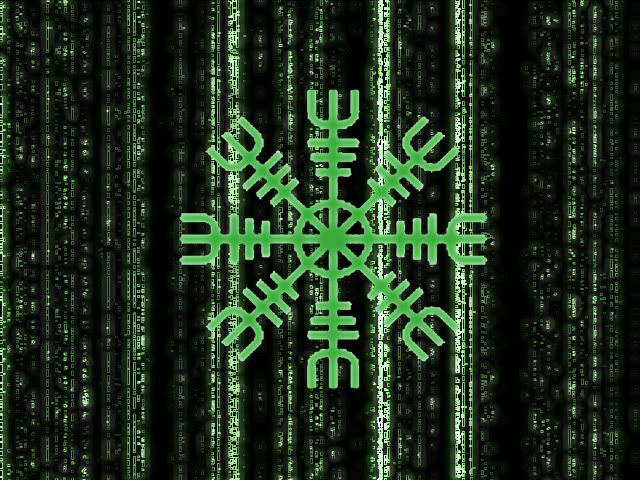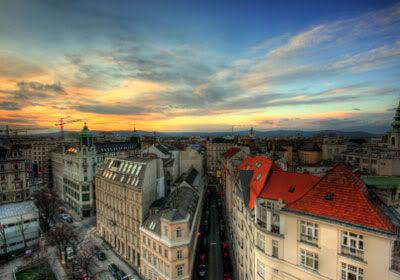The Raido rune
I wasn't going to look at another one of von List's runes here, but perhaps just one more. The numerous names that he used for it did not include "raido," so I actually had to look it up since I'm not especially familiar with the rune names other than a few. Naturally I was familiar with this runic symbol itself.
This post could have some material that some would put in the category of what I would call "guilt by association." All I can say is that I see this as partly a spiritual endeavor. By that, I mean earth-based religion(s). I see a lot of beautiful and powerful ancient symbolism in particularly Alpine Gaulish, Germanic, Slavic cultures; and even from proto-European cultures like the Camunni. These aren't necessarily runic artifacts found in some cave. Some of these pre-Roman, Alpine cultures were far more advanced than archeologists had previously thought. Recent digs from Celtic peoples in modern France and south Germany have shown that their architecture often consisted of an underground cellar, a strong stone foundation, with a finely-constructed two-story wooden building on top. They had trade routes, marketplaces, metalurgy, fine art, weaponry, leather products, and a system of tribal identity-socialism. Everyone was accounted for. Nobody went hungry.
**************************************************
Raido means riding as in traveling and moving. On a deeper level, Raido refers to the wheels of a wagon, the mechanism behind which movement actually occurs. To the early germanic people, the wheel was a symbol by which the gods set the universe into motion, a great cosmic wheel by which all the cycles, patterns and orders of the universe move in rhythm too. Being a rune, then, Raido also represents moving in the right direction and doing what is proper and correct.
**************************************************
|
|
English Translation:
|
Old Norwegian
ᚱ
Ræið kveða rossom væsta;
Reginn sló sværðet bæzta.
|
Riding is said to be the worst thing for horses;
Reginn forged the finest sword.
|
Old Icelandic
ᚱ
Reið er sitjandi sæla
ok snúðig ferð
ok jórs erfiði.
iter ræsir.
|
Riding is of sitting a blessing
and swift journey
and horses toiling
|
Anglo-Saxon
ᚱ
Rad byþ on recyde rinca gehwylcum
sefte ond swiþhwæt, ðamðe sitteþ on ufan
meare mægenheardum ofer milpaþas.
|
Riding seems easy to every warrior while he is indoors
and very courageous to him who traverses the high-roads
on the back of a stout horse.
|
References
External
links
**************************************************
 Guido von List's "Raido rune" (he used different names):
Guido von List's "Raido rune" (he used different names):
rit, reith, rath, ruoth, rita, rat [rede], roth, [red], rad [wheel], rod, rott, Recht [right], etc.
A fifth I heard, if from a happy flight
a shot flies into the host;
however swiftly it flies, I will force it to stop
if I can only catch it with my gaze.
The thrice hallowed "Rita," the solar-wheel, the "Urfyr" (primal fire, God) itself! The exalted introspective awareness [Innerlichkeitsgefuehl] or subjectivity of the Aryans was their consciousness of their own godliness, for "internity" is just "being-with-one's-self," and to be with one's Self is to be with God. As long as a people possesses unspoiled their entire original "internity" as a "natural people,"* it also has no cause to worship an external divinity, for an external divine service bound by ceremony is only made obvious when one is not able to find God in one's own innermost being, and begins to see this outside his "ego" and outside the world--"up there in the starry heaven."
The less internal the person is, the more outward his life becomes. The more a people loses its internity, the more pompous and ceremonialized its outward manifestations become--in the character of its government, law, and cult (all of which will begin to emerge as separate ideas). But they should remain one in the knowledge: "What I believe, is what I know, and so I also live it out." For this reason, the Aryan devine-internity is also the basis for a proud disdain for death among the Aryans and for their limitless trust in God and in the Self, which expresses itself gloriously in the "Rita," [cosmic order, law] and which has the fifth rune as its symbolic word-sign. Therefore, this rune says: "I am my rod [right], this rod is indestructible, therefore I am myself indestructible, because I am my rod."
*The "people as a natural people" is not being in a savage condition, for uncivilized "savages" live in the bondage of the most horrible "shamanism." The "people as a natural people," on the contrary, stipulates a high level of culture,yet free from any kind of false sophistication.
**************************************************
 Rachel
Rachel
Sometimes I think that the concept of "Wotan" is simply too big for everyday living. When I use the term "Wotan," I'm not referring to the very recent usage of the word. I am using it in relation to what I think was the more widespead pronunciation. To me, "Odin" sounds more specifically Scandinavian, or even Icelandic; while "Wotan" somehow reminds me more of the ancient mountain forests of central Europe. Wotanism, with all of it's related myths and concepts, is a little much for the 6:00 AM alarm.
I have gotten the impression, from my very limited knowledge of Guido von List, that he may have thought the same thing. He did found a folkish spiritual doctrine which he named "Armanism" after "the Armanen." The Armanen were a priest-class in the pre-Roman German lands. From 'Secret of the Runes', I got the sense that he believed that the more complex concepts and ideas of Wotanism were more of a study for a "priest-class," similar to what we know in the major religions today. In other words, to ease the burden, of a complex spirituality for everyday living, for the average person. Of course, it's going to be there; but it's impractical for it to be twenty-four/seven, if you understand what I mean. Wikipedia, which is pretty good when it's not dealing with subjects on the periphery of "political correctness," has von List wanting to replace "alien Christianity" with Armanism; despite clear evidence to the contrary, as we covered earlier.
We can cover Armanism and other related ideas at a later time. As one can see in von List's interpretation of the Raido rune, there is a close tie-in with the ideas behind Armanism. I think part of the idea was for a simpler version of Wotanism for the masses. I guess what I'm really trying to say is that there is no practical way that a person can truly live by "The Creed of Iron" from dawn to dusk. Life is struggle, and sometimes "going on instinct" cannot be avoided. Often, life is one big fight! Why not just acknowledge that one needs a bare-bones version of one's spiritual path, for everyday living. A "mode of operation" for the daily fight, to be blunt.
One common theme of Armanism is imagery of the natural world, sometimes mixed with shrines or temples with folkish symbology. Often, nudity is depicted as well. When people marry, they form a new kinship. At least that's what was intended, but I can't say that it's always the case today with Western governments totally obsessed with alien ideas. I don't even mean alien to our culture, but more like alien to the human race at large. This kinship was intended to be sacred. A new family construct, still tied to its clan, still tied to its tribe, and still tied to its nation. I think that this kinship was closely connected to the Armanism concept. I don't necessarily mean connected to Wotanism, although that too. That's obvious. But to the spirit of one's daily life. To all the things that might be just mundane, and seemingly not have anything to do with one's spiritual path.
My ex-fiance was named Rachel. She was a physically beautiful woman of Tuscan descent. She had really long straight brown hair. The type of hair that looked very dark in dim light, but could look blondish in the bright sun. Her eyes were basic brown, somewhat prominent, and with thin rounded feminine eyebrows. Her nose wasn't very prominent, probably average for a straight nose. Her skin was a beautiful flesh tone; not ivory, not pinkish, not olive. She had an unusual bite. It's difficult to describe, but it added a certain character to her look. Her head and face were subtly round, with somewhat prominent cheekbones, but her features weren't "heavy." If her personality was even marginally docile, you might even say that she was cute. Her headstrong manner and loud high-pitched voice were in strong contrast to her appearance.
Rachel stood 5'8 1/2" tall, weighed about 140 pounds, and had the natural body of a 70s playboy bunny. She was Mediterranean, but looked almost like a German brunette. When they were into all of that artistic nude pagan-like photography in Germany; hypothetically, I think that they would have been really impressed with Rachel. The wide shoulders, long limbs, the muscularity. She wasn't literally athletic, but she would have been a fine athlete if she had any desire to be. She had large feminine hands which didn't necessarily match her body type. Her surname loosely meant "sun," like the sun-worship of Armanism; and her sister's name was "Rita," like the Raido rune or solar-wheel; and the "R" rune is the same as the "R" in Rachel; so there's the synchronistic connection to this for me.
She had an absolute hold on me, even though her drug use and verbal and even physical abuse made the relationship entirely impractical. Her awesome physical beauty was such that I would have just let her "be boss" if that could finally reconcile our relationship. Yes, I wanted the beautiful Tuscan girl from the East Bay. No doubt about it. Eventually, as her audacity grew, and I finally grew tired of "fixing things," the relationship ended; and she went on to meet her self-appointed destiny.
The only really good memories was the occasional humor. She could be really funny if she wanted to be, but chose not to be for some unknown reason. For example, her childish attempts to "punish me" for some absurd reasoning, could be pretty funny. The contrived attempt to "be mean" to me. Sometimes she would make loud funny comments in public. Things that were true, but nobody had the guts to say it, and people usually laughed at the sheer audacity of it. She was totally serious about those comments, but in her own crazy way,
it was almost like her version of a "dry sense of humor." And, sometimes people would tell me stories of how she did some audacious thing which struck them as funny usually because they didn't know the dark side of her. I sometimes laughed at her misplaced "fighting spirit." Maybe she was a warrior in a previous life, and didn't really fit in well in this life because of it? She needed a war to fight.
I guess I look back at Rachel as a type of "spirit." Not a goddess, but an "energy." If I'm in a good fight, then I want to be like her; but otherwise, I don't want to be like her. Like a "spirit-energy" to draw upon from memory. This energy could also represent, for me, wasted talent. Misplaced energy. If she put all that energy into a business maybe, she probably could have been very successful. So, maybe it's like a lesson too. Use your energy and resources wisely. Originally I wanted to mention her because she reminded me of certain aspects of Armanism, for me. Maybe she is like a goddess for me. Sort've like an aloof goddess, like the god Loki.
~RIP my dear ♥~
.

















